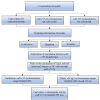Helicobacter pylori CagA Protein Regulating the Biological Characteristics of Gastric Cancer through the miR-155-5p/SMAD2/SP1 axis
- PMID: 36014967
- PMCID: PMC9414533
- DOI: 10.3390/pathogens11080846
Helicobacter pylori CagA Protein Regulating the Biological Characteristics of Gastric Cancer through the miR-155-5p/SMAD2/SP1 axis
Abstract
Helicobacter pylori (Hp) is a grade Ι carcinogen of gastric cancer (GC), and its high infection rate seriously affects human health. Cytotoxin-associated gene A (CagA) plays a key role in the carcinogenesis of Hp as one of its main virulence factors. miR-155-5p is abnormally expressed in patients with GC, associated with the occurrence and development of cancer. However, little is known about the association between CagA and miR-155-5p. (1) Background: This study explored the association and mechanism of CagA and miR-155-5p in GC. (2) Methods: The CagA sequence was obtained from the NCBI. After sequence optimization, it was connected to the pcDNA3.1 vector to construct a CagA eukaryotic expression plasmid (pcDNA-CagA). Quantitative real-time polymerase chain reaction (qRT-PCR) was used to investigate the expression of miR-155-5p and CagA in GC cells. The function of CagA on GC cells was detected by CCK8, wound healing, and Transwell assays. Similarly, the function of miR-155-5p was also studied through the above functional experiments after the miR-155-5p overexpression and knockdown models had successfully been constructed. The associations among CagA, miR-155-5p, and SMAD2/SP1 were evaluated using RNA immunoprecipitation (RIP) and rescue experiments. (3) Results: The expression of miR-155-5p was significantly reduced in GC cells, and the expression of miR-155-5p was further reduced after CagA induction. Both overexpressed CagA and knockdown miR-155-5p cell models enhanced malignant transformation, whereas overexpressed miR-155-5p inhibited malignant transformation in vitro. The function of miR-155-5p on GC cells could be influenced by CagA. We also found that the influence of miR-155-5p on SMAD2 and SP1 could be regulated by CagA. (4) Conclusions: CagA potentially regulates the biological function of GC cells through the miR-155-5p/SMAD2/SP1 axis. miR-155-5p could be a therapeutic target for GC related to CagA.
Keywords: CagA; SMAD2; SP1; gastric cancer; miR-155-5p.
Conflict of interest statement
The authors declare no conflict of interest.
Figures






Similar articles
-
Cytotoxin-Associated Gene A-Positive Helicobacter pylori Promotes Autophagy in Colon Cancer Cells by Inhibiting miR-125b-5p.Can J Infect Dis Med Microbiol. 2021 Mar 2;2021:6622092. doi: 10.1155/2021/6622092. eCollection 2021. Can J Infect Dis Med Microbiol. 2021. PMID: 33791049 Free PMC article.
-
Circ_0000620 acts as an oncogenic factor in gastric cancer through regulating MMP2 expression via sponging miR-671-5p.J Biol Res (Thessalon). 2021 Dec 31;28(1):23. doi: 10.1186/s40709-021-00154-5. J Biol Res (Thessalon). 2021. PMID: 34972532 Free PMC article.
-
Silencing circSLAMF6 represses cell glycolysis, migration, and invasion by regulating the miR-204-5p/MYH9 axis in gastric cancer under hypoxia.Biosci Rep. 2020 Jun 26;40(6):BSR20201275. doi: 10.1042/BSR20201275. Biosci Rep. 2020. PMID: 32496549 Free PMC article.
-
Helicobacter pylori CagA promotes the malignant transformation of gastric mucosal epithelial cells through the dysregulation of the miR-155/KLF4 signaling pathway.Mol Carcinog. 2019 Aug;58(8):1427-1437. doi: 10.1002/mc.23025. Epub 2019 Jun 4. Mol Carcinog. 2019. PMID: 31162747
-
Cryptotanshinone inhibits cytotoxin-associated gene A-associated development of gastric cancer and mucosal erosions.World J Gastrointest Oncol. 2021 Jul 15;13(7):693-705. doi: 10.4251/wjgo.v13.i7.693. World J Gastrointest Oncol. 2021. PMID: 34322198 Free PMC article.
Cited by
-
MicroRNA-155 and its exosomal form: Small pieces in the gastrointestinal cancers puzzle.Cell Biol Toxicol. 2024 Sep 16;40(1):77. doi: 10.1007/s10565-024-09920-2. Cell Biol Toxicol. 2024. PMID: 39283408 Free PMC article. Review.
-
Hp0521 inhibited the virulence of H. pylori 26,695 strain via regulating CagA expression.Heliyon. 2023 Jul 1;9(7):e17881. doi: 10.1016/j.heliyon.2023.e17881. eCollection 2023 Jul. Heliyon. 2023. PMID: 37539313 Free PMC article.
-
Traditional Chinese medicine in the treatment of Helicobacter pylori-related gastritis: The mechanisms of signalling pathway regulations.World J Gastroenterol. 2025 Jan 21;31(3):96582. doi: 10.3748/wjg.v31.i3.96582. World J Gastroenterol. 2025. PMID: 39839895 Free PMC article. Review.
-
Fusobacterium periodonticum BCT protein targeting glucose metabolism to promote the epithelial-mesenchymal transition of esophageal cancer cells by lactic acid.J Transl Med. 2024 Apr 30;22(1):401. doi: 10.1186/s12967-024-05157-z. J Transl Med. 2024. PMID: 38689341 Free PMC article.
References
LinkOut - more resources
Full Text Sources
Research Materials
Miscellaneous

